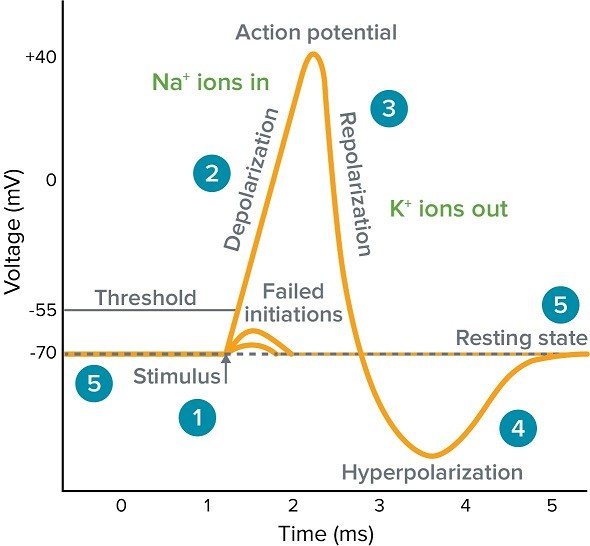How Do Neurons “Fire”?
Episode #3 of the course Understanding your brain by Betsy Herbert
Welcome back!
Last lesson, we learned what a neuron is. In the following two lessons, we’re going to learn exactly what it does—and how.
We’ve learned that a neuron transmits information in the form of an electrical signal down its dendrites to its axon, and then passes it on to a new neuron farther along the network. No matter what this information is conveying—a signal telling your stomach to digest food, the sensation of warmth when you hold someone’s hand, the concepts you need while you solve a difficult math problem—it’s all carried by the same “stuff.” And it’s the same stuff that’s powering your laptop and lightbulbs: electricity.
But how is this electricity generated? Don’t you need wires and batteries? Not necessarily. Electricity is just the flow of electric charge. Neurons simply channel their own charged particles (positively-charged sodium and potassium ions) down their own “cables” (their axons and dendrites).
Now, these charged ions don’t just flow passively down the neuron’s wires like electrons in a circuit. If they did, the information wouldn’t be transferred fast enough for us to think and act quickly. So instead, an incredible process takes place, involving very quick reversals of ionic charge at regular points along the axon or dendrite, known as action potentials. These action potentials “travel” along the neuron like an audience wave at a football game, resulting in a fast burst of electricity zipping along the length of the neuron. This is what we mean when we say a neuron “fires.” Let’s learn how it happens.
The Resting Potential
Picture a small section of a neuron’s axon, where an action potential is about to occur. In its resting state, the inside of the axon is negatively charged relative to the environment. It’s kept this way because a protein called an ion exchanger in the axon’s wall makes positively-charged sodium ions accumulate outside the cell, leaving the inside comparatively negative. In electrical terms, we say that there’s a voltage or potential difference across the cell membrane; it’s about -70mV, and it’s called the resting potential.
Now, nature doesn’t like it when things aren’t in equilibrium. The positive ions on the outside would rather flow inward, and those on the inside would rather flow out. But while the neuron is inactive, the ions are forced into this imbalanced state, keeping them poised and ready for action. It’s a bit like a compressed spring, waiting to release its energy.
The Action Potential
When an action potential occurs just upstream of our section of axon, it’s triggered into action. Tiny “gates” in the axon wall called sodium channels start to open, allowing the sodium ions outside to flood into the cell. Because the sodium ions are positive, the inside becomes less and less negative relative to the outside and eventually, becomes positive itself. This is called depolarization.
Once all the sodium channels are open, they shut down and become inactive. Then a different type of gate opens—the potassium channels—allowing potassium ions inside the cell to flood outward to restore the electrical equilibrium. This is called repolarization. Often, the potassium ions “overshoot” a little, making the inside too negative; this is called hyperpolarization.
So: depolarization, repolarization, and hyperpolarization. Together, this makes an action potential. Essentially, it’s a bunch of sodium ions flowing in, followed by a bunch of potassium ions flowing out, but it creates a very interesting electrical event. If we plot the membrane potential on a graph, we can see this for ourselves:

Can you see how this looks a little like a wave? Can you imagine how it might be able to “travel” down the neuron just like an oscillation in a rope would? It’s an abstract visualization, but it’s essentially what happens.
We’ll learn all about it next lesson.
See you then!
Betsy
Learn Something New Every Day
Get smarter with 10-day courses delivered in easy-to-digest emails every morning. Join over 400,000 lifelong learners today!
Recommended video
The Nervous System, Part 2 — Action! Potential!
Share with friends

